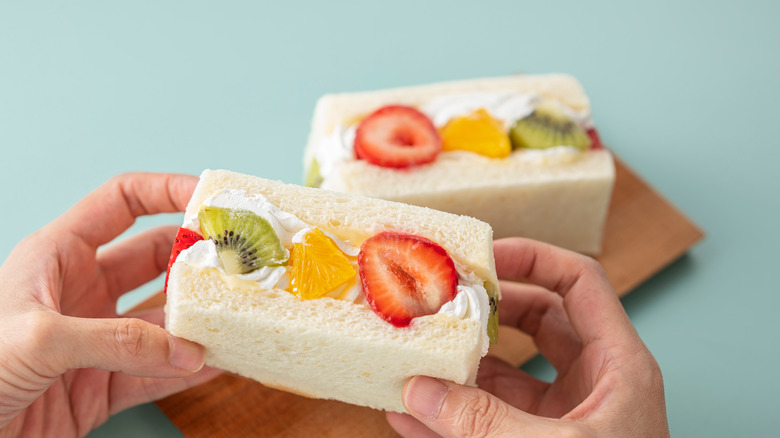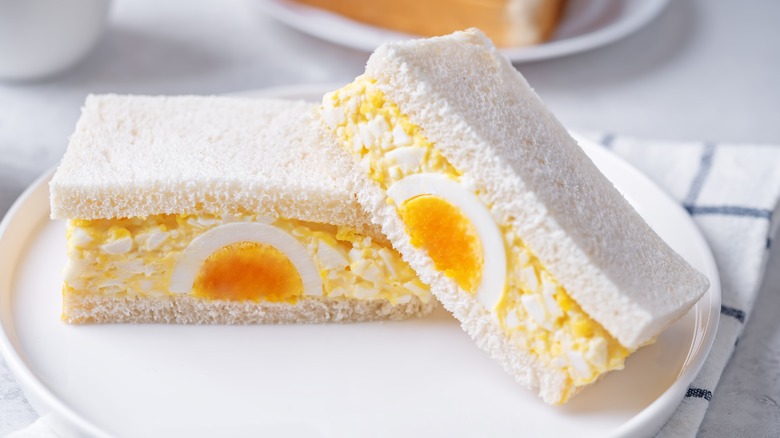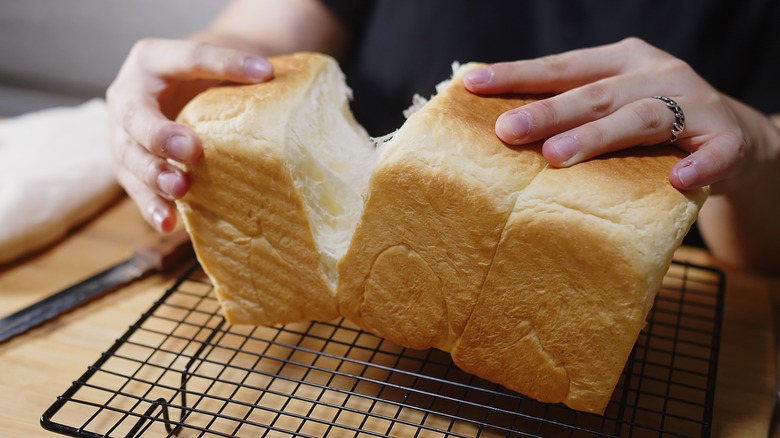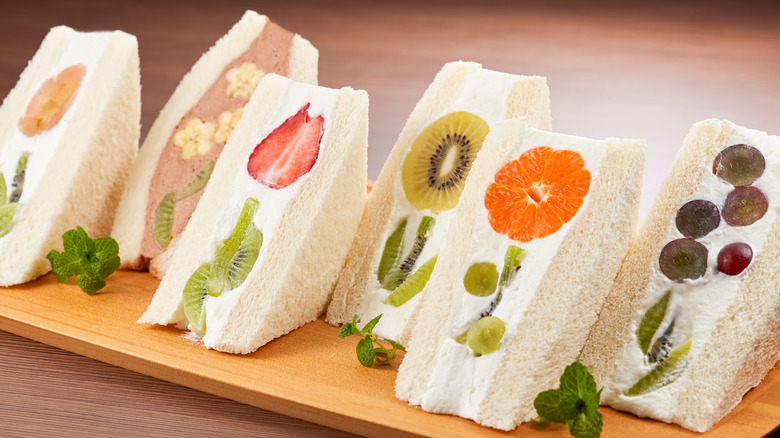The Right Bread To Use For Japanese Sandos
Modern Japanese cuisine has a lot of Western influence. Why? Blame the Meiji Restoration. When Japan opened after centuries of isolation, Western food became a status symbol. The government even encouraged a Western diet, which was seen as heartier than traditional Japanese fare. Over time, Japanese cooks put their own spin on Western classics. Now, Western-inspired dishes — called yoshoku — are a key part of Japanese cuisine. Some yoshoku are recognizable (albeit with a Japanese twist), while others could pass for traditional dishes. Some, like Japanese sando, make Westerners do a double take.
Sando are Japanese sandwiches, but they don't look like their Western counterparts. Sando are made with thick, fluffy bread, and popular fillings include fruit and katsu. They're a staple of Japan's famously fabulous convenience stores, but you can make them at home, too. To learn how, The Takeout talked to Namiko Hirasawa Chen. Chen is the founder of Just One Cookbook, a blog dedicated to Japanese food and culture.
Chen started her blog in 2011. Since then, Just One Cookbook has grown into the top English-language site for Japanese recipes, with shoutouts from The New York Times, The Washington Post, and The New Yorker. Ten years ago, Chen published a cookbook based on recipes from the site — but found that one cookbook actually wasn't enough. She's since published two more volumes. Chen's sando advice? Pick the right bread.
What kind of bread should you use for Japanese sando?
If you want to make sandos that taste just like the ones in Japan, plain old Wonder Bread — or even bougier options like French brioche — won't do. Yes, store-bought white bread or brioche are good options in a pinch, but for the authentic sando experience you'll need Japanese milk bread, otherwise known as shokupan.
"We always use pillowy and sweet shokupan for tamago (egg salad) sando in Japan," Chen explained. "[Shokupan is] the perfect soft and fluffy texture to go with the creamy and sweet egg salad." Balking at the idea of a sweet egg salad sandwich? Don't knock it 'til you try it. The subtly sweet flavor is one of the things that makes tamago sando unique.
It's not the only sweet sando, either. Fruit sando, filled with whipped cream and flavorful fruit, is one of the most popular kinds. It's a little like strawberry shortcake — but without the shortcake. "We use shokupan for fruit sando for its soft texture and milky sweetness as well," said Chen.
Why should you use shokupan for sando?
Traditionally, bread wasn't a big part of Japanese cuisine. Foreigners brought white bread to Japan in the 1800s, but shokupan (or Japanese milk bread) didn't appear until after World War II. Now, it's a staple. Japanese families now spend more on bread than on rice, the country's traditional carb of choice. The go-to type? Shokupan.
Shokupan's star ingredient is, you guessed it, milk. Similar to brioche, milk gives shokupan a richer, fattier taste than standard loaves. But unlike brioche, shokupan isn't weighed down by eggs or butter which gives it a lighter, fluffier texture. This texture is characteristic of many Western-style Japanese treats, like soufflé pancakes, Japanese cheesecake, and Swiss rolls. It even has its own word: fuwa fuwa (which translates as 'fluffy').
Shokupan comes in two types, kakugata and yamagata. Yamagata shokupan has a rounded top, like a standard American supermarket loaf. Kakugata shokupan is baked with a lid, so it has a flat top and squared-off shape. The lid keeps moisture in, too, so the bread is extra moist and chewy. Shokupan's unique texture helps stave off sogginess. That (combined with its squared-off shape and large size) makes it the perfect medium for sando. You can bake shokupan yourself, but it's not for novices. Check Asian bakeries first. While the bread was once a rarity in the West, Americans are falling in love with shokupan.
What kind of fruit should you use for Japanese fruit sando?
Chen also dished on the best fruits for Japanese sando. "The filling for Japanese fruit sando is fresh whipped cream and colorful fruit," she said. "Typical fruits for Japanese fruit sando are strawberries, oranges, kiwis, mangoes, and blueberries." Fruit is a big deal in Japan. Fruit-themed cafés sell sando and other fruit-focused desserts. Square watermelons and $4,000 strawberries regularly make headlines. Japanese farmers focus on quality. When you're making fruit sando, use high-quality fruit. After all, it's the star of the show.
Don't forget aesthetics, either. Looks aren't everything, but part of the sando's charm is its pretty appearance. In Japan, cafés and convenience stores use eye-catching fruit sando to vie for customers. Sometimes, sandwich makers arrange fillings to form pictures or patterns when the sandwich is sliced.
You don't have to go all-out with fancy designs, but put a little effort into making your fruit sando look nice. It's part of the sando experience. As Chen explained, "You can use a single fruit or a combination—it's really up to you, but use a colorful one!"



